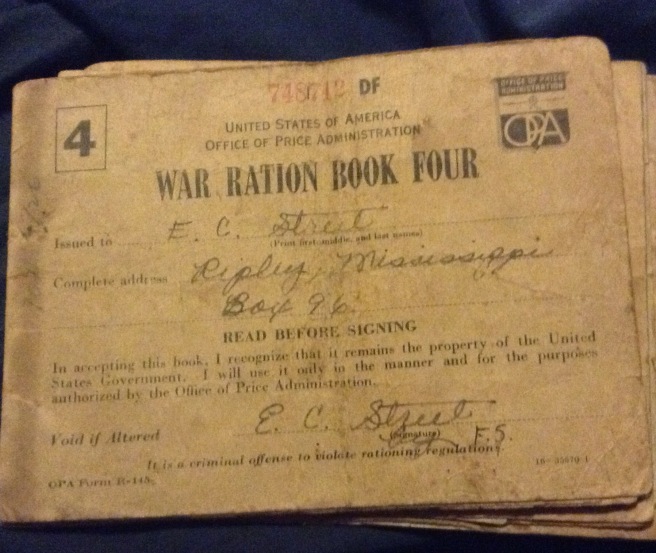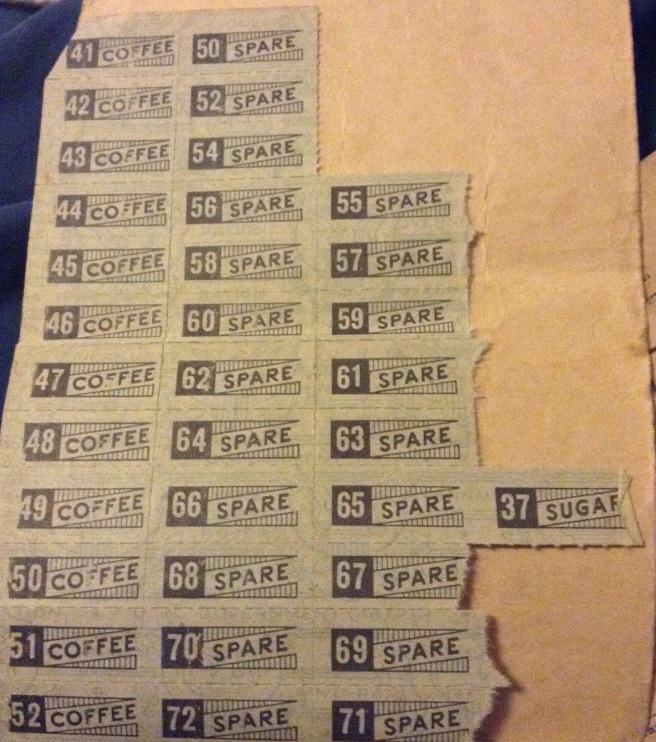Since my grandmother was the last of her siblings to marry, she got all of her parents’ things and that’s how I ended up with them. But a ration book from the Second World War was not what I could have thought of finding. I ended up with three different sets of ration books: my great-grandparents and their youngest son, Uncle Frank.

Ration books were filled with stamps used to purchase certain goods such as sugar, processed foods, meats, flour, shoes, clothing, gas, coffee, and even tires. This was meant to ensure that everyone had a fair chance to obtain the necessities, keep rich folks from buying and hoarding, and keep people from being ripped off by prices being raised to meet high demand, as well as preventing a black market of goods.

My great-grandparents tried to be self-sufficient so the ration books look almost unused. Mostly they bought sugar and flour and splurged on clothing to help their daughters get married. They didn’t do without.
Ration books are a glimpse into a past I know I can scarcely imagine. I’m spoiled by being able to go to the store and buy what I need, however much I need of it. I can’t imagine being limited by stamps or signs proclaiming limits on how much I can buy.
But I think, even if they complained, they believed the sacrifices worth it to support the boys overseas.

Thank you for that. When I was researching this post, that was how I understood it — an exchange of stamps for goods.
LikeLike
I have my own ration books from WWII – the first one was issued when I was just 7 weeks old.
One correction to your post: The stamps were not used as money. They were used to prove that you were eligible to buy certain commodities that were in short supply and therefore needed to be rationed. A person was permitted to buy only certain amounts of these items per month. Everyone was issued ration books, even infants,, to ensure that every family had adequate access to the rationed items. Stamps could not be removed from books until the time of purchase – the retailer had to personally tear out each stamp. The purpose of this was to try to make sure that stamps could not be hoarded or sold on the black market.
LikeLike
Thank you, Jana! Have a great weekend, too!
LikeLike
Lacey,
I want to let you know that your blog post is listed in today’s Fab Finds post at http://janasgenealogyandfamilyhistory.blogspot.com/2015/03/follow-friday-fab-finds-for-march-6-2015.html
Have a great weekend!
LikeLiked by 1 person
I plan on keeping them for as long as I can.
LikeLike
Thanks! What did she say?
LikeLike
So funny you should post this. Just this weekend I was at my grandmother’s house going through old family history papers and photos and came across some ration books! I had never seen them before so I was able to ask her about them and why she had so many stamps left!
LikeLiked by 1 person
Thank you for this wonderful post. My grandmother had them. Your post brought back some great memories. I think it’s really cool that you still have them.
LikeLiked by 1 person
No problem. Thanks for reading.
LikeLike
Thank you so much for sharing. I’ve read about ration books but I’ve never seen one before.
LikeLiked by 1 person